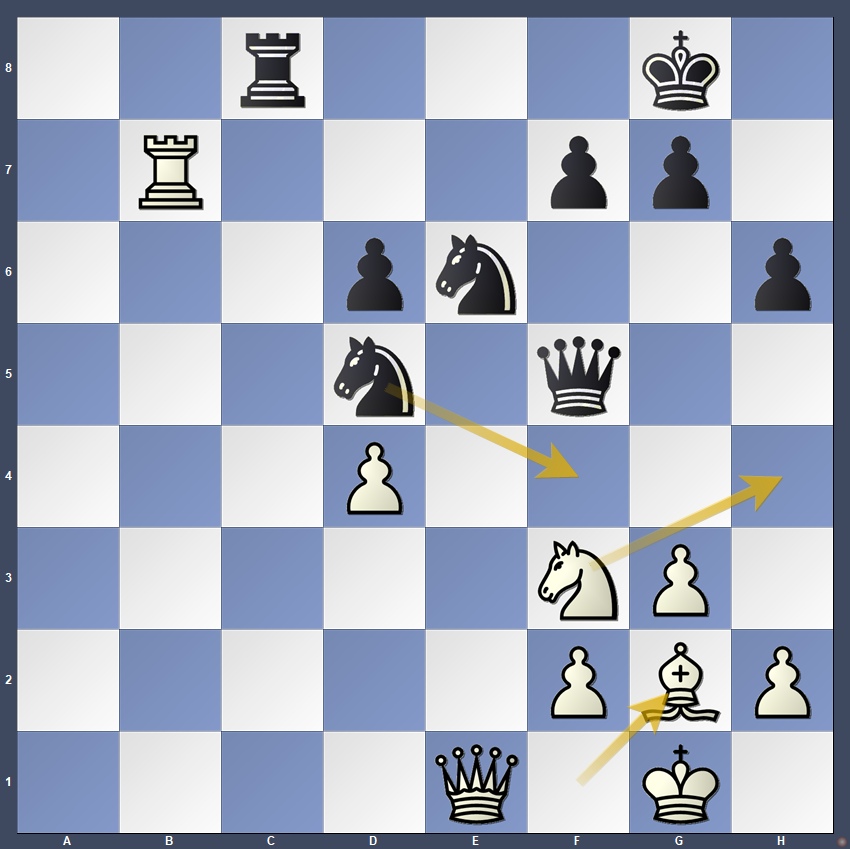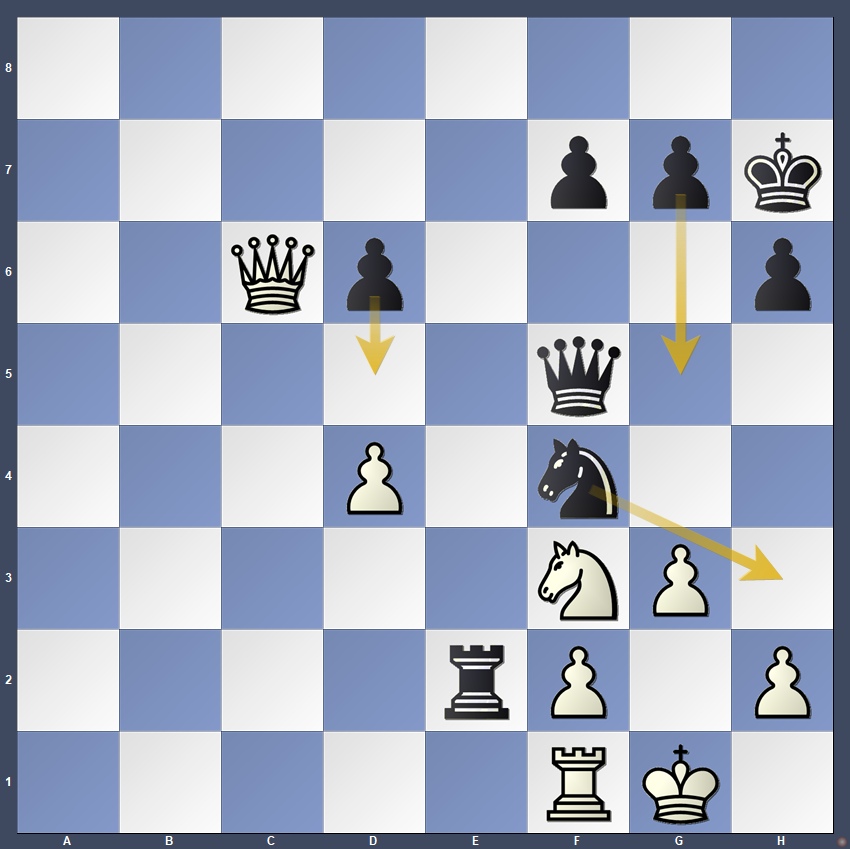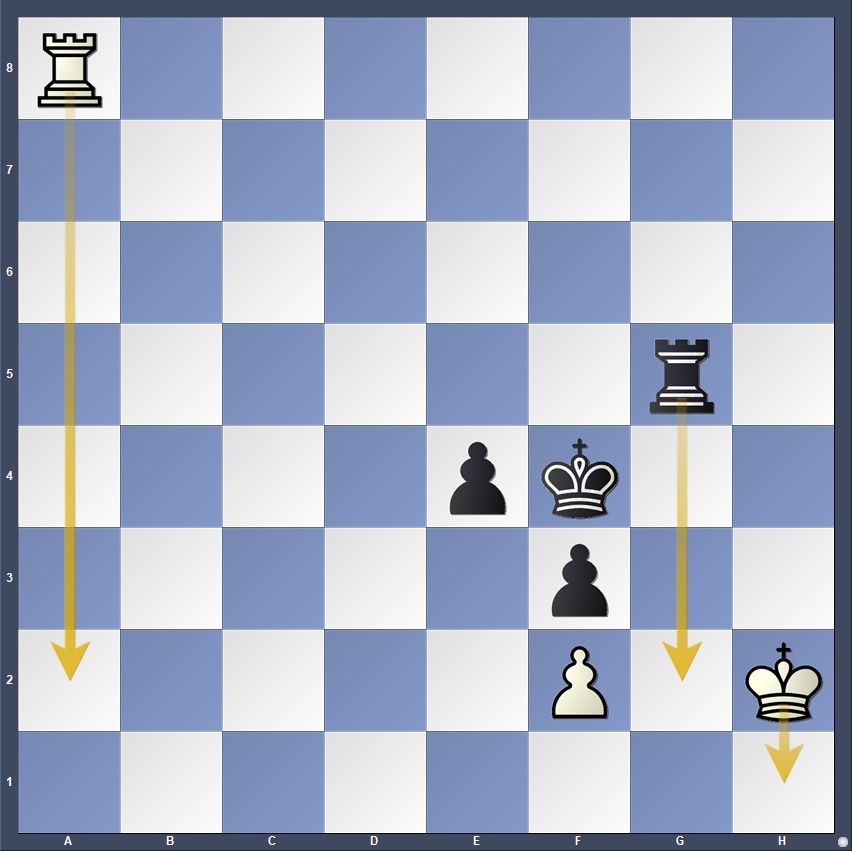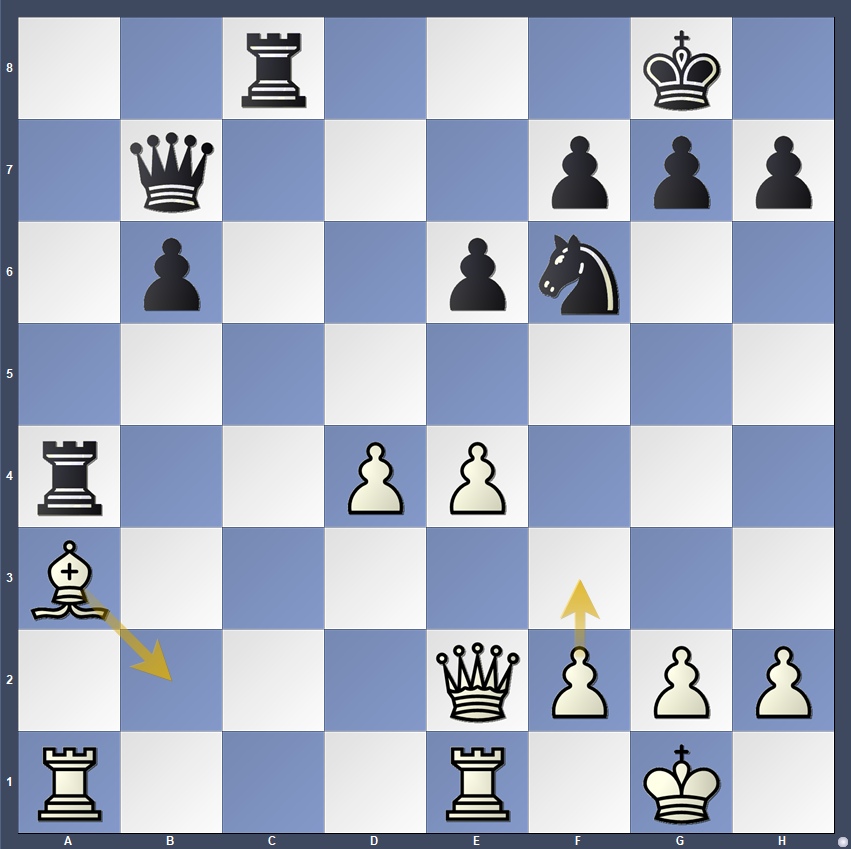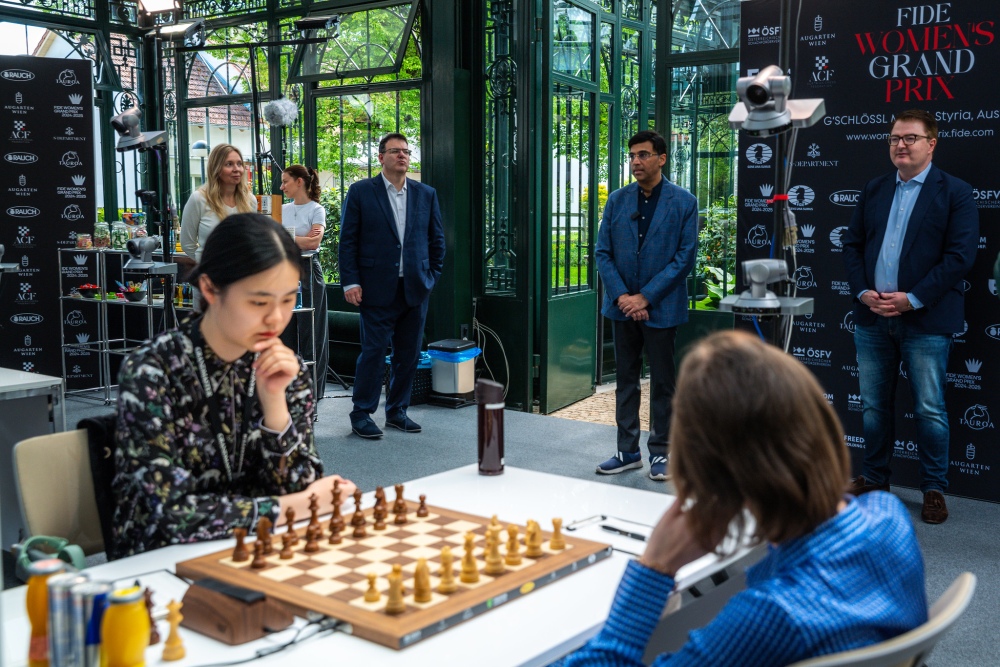
Chinese stars Zhu Jiner and Tan Zhongyi led the charge with crucial victories, while Alexandra Kosteniuk and Vaishali Rameshbabu also bounced back with important wins.
For the best part of round six in the FIDE Women’s Grand Prix, it seemed that this would be a calm day on the chessboards. What began as a seemingly tranquil round turned into a thrilling display of sharp moves and nerves.
Anna Muzychuk continues to lead with 4.5/6, after she drew with Nana Dzagnidze the only peaceful game of the day. Zhu Jiner scored her fourth victory, securing sole second place, half a point behind Anna. The two are the only players with a chance to win the overall 2024/2025 WGP season and get a spot in the 2026 Women’s Candidates.
Congratulations go to former World Champion Tan Zhongyi, who ground down Salimova in what seemed to be a dead-drawn rook endgame. It was the longest game of the round, lasting five hours and 89 moves.
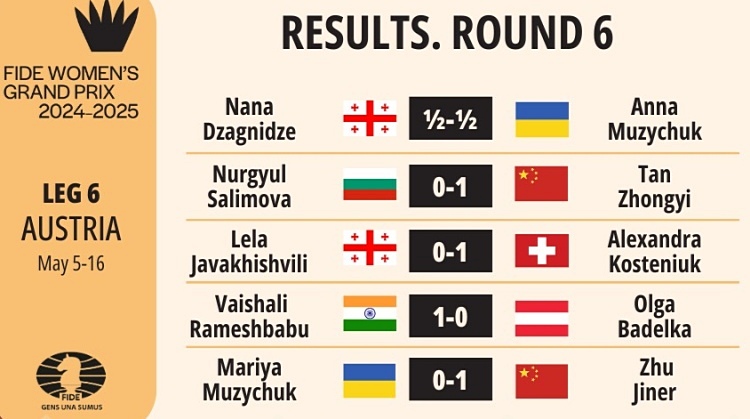
The most intense game of the day was between Mariya Muzychuk and Zhu Jiner. In the Murphy Defence of Ruy Lopez, the position was even until the late stages of the middlegame when Muzychuk overlooked a tactical attack by Black.
Mariya has just played the most natural move 31.Bg2? (after 31.Nh4 position is equal) but missed 31…Ndf4!! The knight is taboo – 32.gxf4 fails to 32…Nxf4 33.Re7 Nxg2 and if 34.Kxg2 then Qg4+, regaining piece, with a pawn advantage and a dominating position. White should have played 32.Qe3 here, defending the f3-knight, although, after 32…Rc3 her position is no fun. Instead, she blundered.
32.Rb1? Nxg2 33.Kxg2 Nf4+!! 34.Kg1 Nh3+ 35.Kg2 Rc2 36.Qe8+ Kh7 – and Black is completely winning.
Although Zhu later gave Muzychuk a fleeting chance to equalise the Ukrainian missed her opportunity.
Black should have proceeded with Nh3+ and g5, pressing and holding everything. Instead Zhu carelessly played 41…d5? giving respite to White in a position where she could almost not do anything!
But Muzychuk erred. Instead of activating her knight with Nh4 and going for counterplay, she played 42.Qc3?, missing the only chance she got to save the game.
In the next move, Zhu was on target – 42…g5! 43.Ne1 g4 44.Qd3 Removing the queens in the hope of a respite, but that didn’t help.
44…Qe4 45.Qxe4 dxe4 White ran out of moves. 46.Kh1 – giving up a pawn, but 46.d5 is met with 46…Rd2 followed by e4-e3) 46…Nxf2. The white king is in a mating web, and the pieces are pinned to the first rank. Five moves later Mariya capitulated.
A well-deserved victory for Zhu – her fourth win in a row.
Tan outlasts Salimova in a dead draw
The second game that marked round six of the WGP in Austria was played by another Chinese – Tan Zhongyi, who defeated Bulgaria’s Nurgyul Salimova.
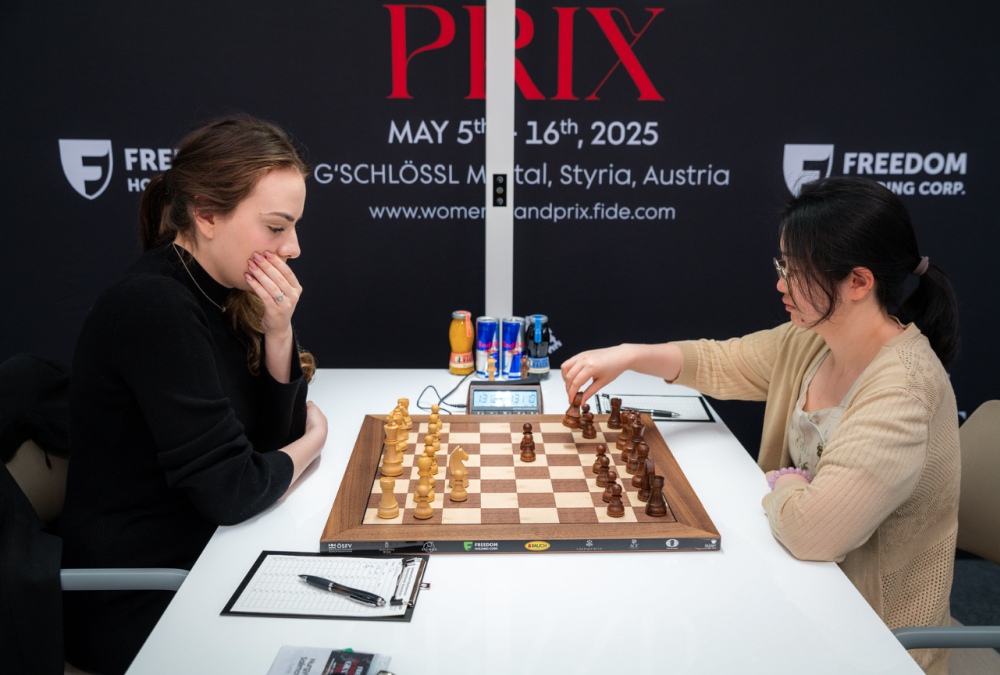
After scoring her first victory in round five (an effective win against Kosteniuk), Nurgyul Salimova was in a buoyant mode against former World Champion Tan. Salimova played the King’s Indian Attack – an uncommon opening on grandmaster level. The Bulgarian was pushing on the queenside, but spent a lot of time thinking and didn’t succeed in creating any real opportunities. By move 28, the two transitioned to a rook endgame, where White had a 2:1 pawn advantage on the queenside. Still, Nurgyul had one major problem – time. With just six minutes on the clock (compared to Tan’s 46), Salimova needed to make 10 moves to reach the first time control, which isn’t easy in a rook endgame.
Soon, a pair of rooks and pawns was exchanged. The two entered a rook endgame with White having a runner on the a-file. The position was even and everyone anticipated a quick draw. But Tan refused to settle. White soon abandoned her pawn, demonstrating the impregnability of her position, but Tan was determined to drain blood out of stone.
And it eventually paid off. After White first lost her h-pawn, it was still a drawn endgame, but Tan had the psychological advantage.
After 80 moves – 53 of which were spent on a rook endgame – Salimova finally broke.
White should have moved her king to the corner with 81.Kh1, avoiding a double attack with …Rg2. If Black did go for 81..Rg2, she would then have a perpetual check from Black’s back ranks using the well known mad-rook motif. For example: 81.Kh1 Rg2 82.Rf8+ Ke5 83. Re8+ Kd5 84.Re5+! Kd4 (84..Kxe5 – stalemate!) 84.Rxe4+ and so on.
However, Salimova played 81.Ra2?? and after 81…Rg2+ 82.Kh1 Kg4! Tan soon proceeded to take the second pawn and win.
A remarkable show of perseverance from the former Women’s World Champion, who has so far had three victories, two defeats and one draw in the tournament.
A great victory in a “miserable tournament”
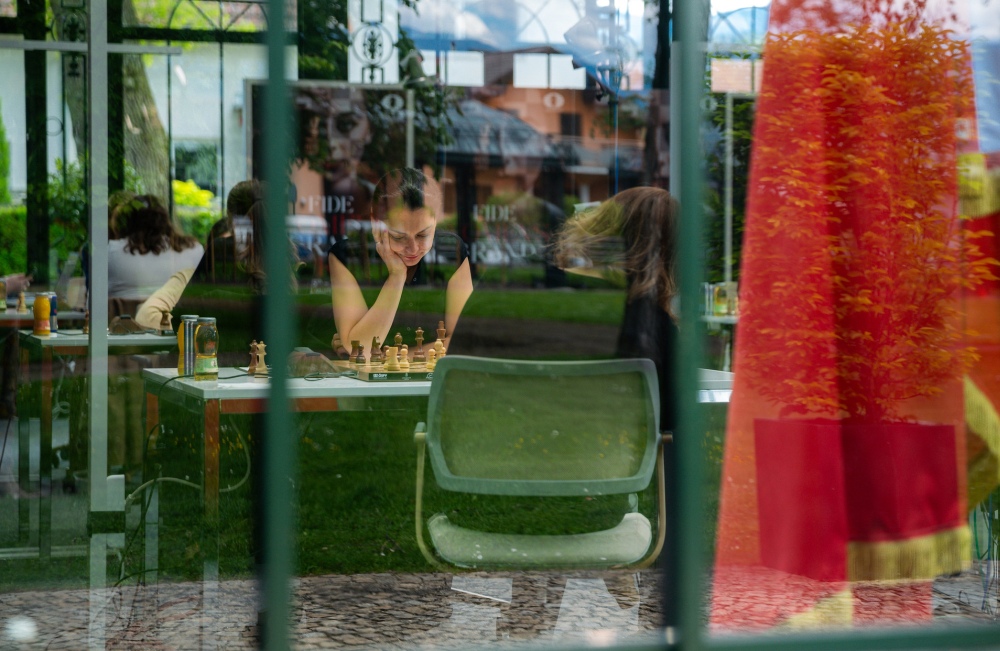
Another former Women’s World Champion – Alexandra Kosteniuk – also won. In the words of Grandmaster Emil Sutovsky, Kosteniuk had “a miserable tournament” so far – with just 1.5 points from five games. In round five she was upset by Salimova in a game where Kosteniuk had a significant advantage. Despite the shock, today she was back in good form and fighting spirit.
Playing with the black pieces against Georgia’s Lela Javakhishvili, Kosteniuk achieved a solid position in the Colle system. As early as move 11, Javakhishvili gave up a pawn but got a sufficient compensation. On move 17, Black gave back the pawn but enjoyed a comfortable position.
A few moves down the line, approaching time trouble – White made a heavy blunder.
23.Bb2? The optimal choice was to play 23.f3, giving up her d4-pawn but getting some activity after 23…Rxd4 25.Qb5. Any attempt to defend the d4-pawn is dangerous.
As played, Black won the much more important e4-pawn after 23…Rxa1 24.Rxa1 Nxe4. Black has multiple things going in her favour: an extra pawn, a runner on the b-file, an excellent d5-square for the knight and the command of the c-file.
White continued to resist, but Kosteniuk activated her king and broke through on the kingside, sealing a comfortable victory.
Being on 2.5 points out of six games is not what Kosteniuk was hoping for.
Vaishali comes back after a loss
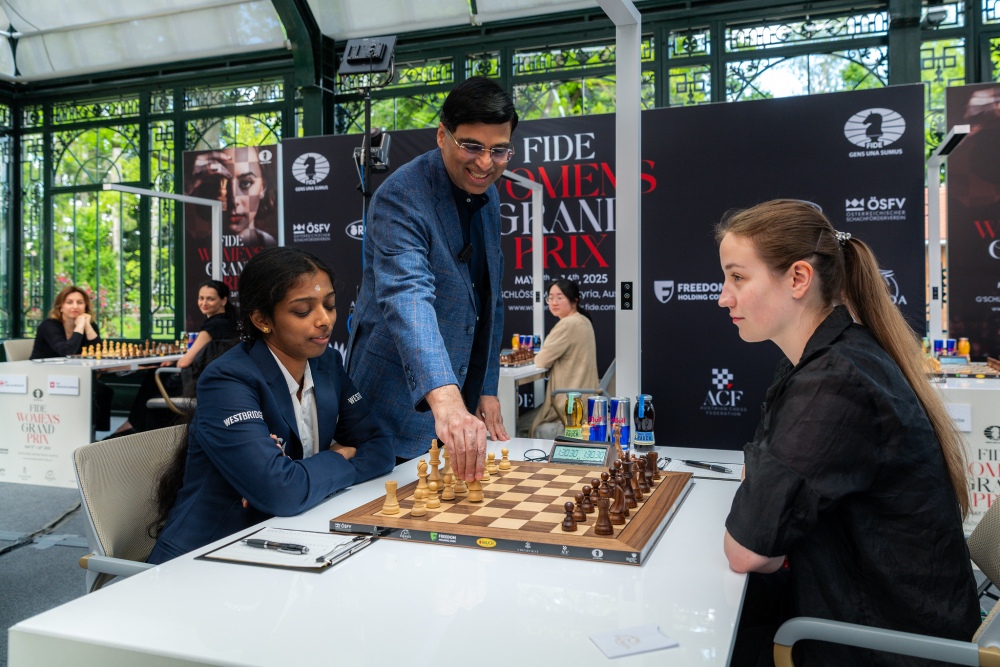
After a heavy loss to Zhu Jiner in round five, Vaishali Rameshbabu today defeated Olga Badelka. In the Four Knights Game, Vaishali – who was playing as White – started outplaying her opponent from move 16. Two moves later, after Badelka’s blunder, she was a pawn up and dominating. Badelka fought on, but the position was hopeless. Facing imminent mate, she resigned on move 39.
A strong comeback from Vaishali after a defeat. She is now on 4/6. Austria’s Olga Badelka continues to struggle, with two points.
The only draw of the day
Anna Muzychuk entered the round as the sole leader, a full point ahead of the rest. In Round 6 she had black pieces against Nana Dzagnidze. In the exchange line of the Grünfeld Defence, Black managed to equalise, forcing the removal of queens and several pieces off the board. Still – as in many cases before this one – Nana was spending more time thinking.
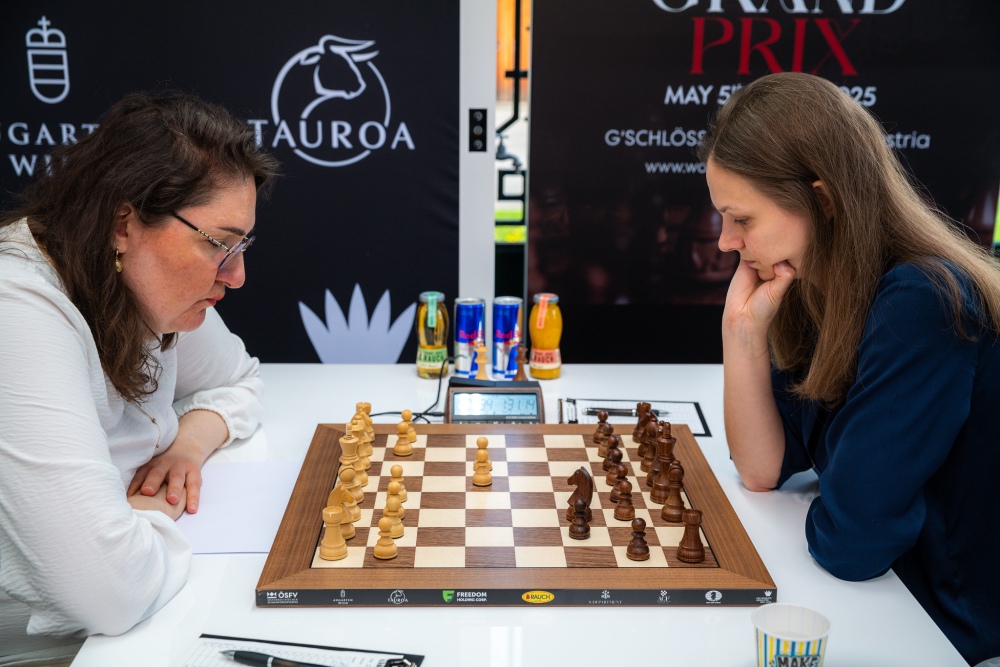
After three hours of play and 24 moves, the position was completely even. But there was one problem: Anna Muzychuk had 40 minutes on the clock, while Nana was down to eight. However, after further simplifications, the two transitioned to a bishop and rook endgame with three pawns each on the kingside. After a threefold repetition, a draw was agreed on move 40.
In the post-game interview, Anna Muzychuk said she didn’t see any chances for her, even with the advantage on the clock.
A Grandmaster duo of commentators
Round six also saw a special treat for the online audience, following the broadcast.

Chess commentator Angelika Valkova was joined by five-time world champion Vishy Anand in the commentary booth. FIDE CEO and Grandmaster Emil Sutovsky also joined for the greater part of the round, so the viewers enjoyed a rich mix of conversation and deep analysis from the commentating team.
Standings after Round 6:
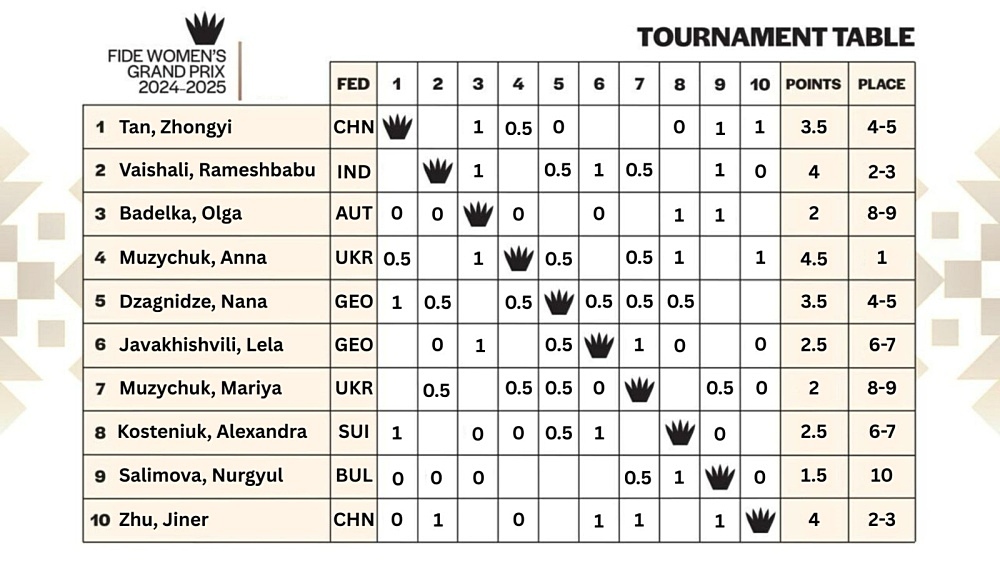
Monday, May 12 is the rest day of the tournament. Games continue on Tuesday, May 13, at 3PM CET. While no classical games will be played, the day will feature a friendly blitz tournament with local Austrian girls, followed by a Michelin-star dinner for the players and guests.
Round 7 pairings:
Zhu Jiner – Nana Dzagnidze
Olga Badelka – Mariya Muzychuk
Alexandra Kosteniuk – Vaishali Rameshbabu
Tan Zhongyi – Lela Javakhishvili
Anna Muzychuk – Nurgyul Salimova
Written by Milan Dinic
Photos: Przemysław Nikiel
About the tournament:
The tournament in Grosslobming is the final in a series of six tournaments in the 2024/2025 Women’s Grand Prix cycle.
Format: Ten players play a round-robin tournament (9 rounds). The time control is 90 minutes for the first 40 moves, followed by 30 minutes for the rest of the game, with an increment of 30 seconds per move starting from move 1.
Prize fund: €120,000 distributed among 10 participants based on placement (see Regulations)
For more information about the event, visit: womengrandprix.fide.com/
About the Women’s Grand Prix series
The FIDE Women’s Grand Prix (WGP) Series 2024–25 stands as a premier series in the international women’s chess calendar. In its seventh season, it serves as one of the crucial pathways to the Candidates.
The event comprises six tournaments, hosted in different countries: Georgia, Kazakhstan, Monaco, Cyprus, India and Austria.
The scoring system is conceptualised in a way that favours not just tournament victories, but consistency across events. Each player has a right to play in three out of the six events in the series.
The event is part of FIDE’s World Championship cycle, and the top two players in the WGP will qualify for the 2026 Candidates tournament. The winner of the Candidates will become the challenger to the current Women’s World Champion Ju Wenjun, who successfully defended her title against Tan Zhongyi in their 2025 match.



